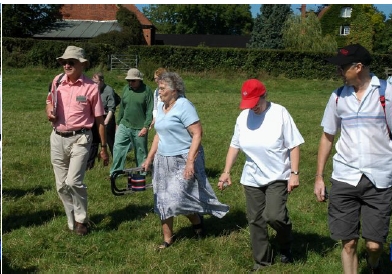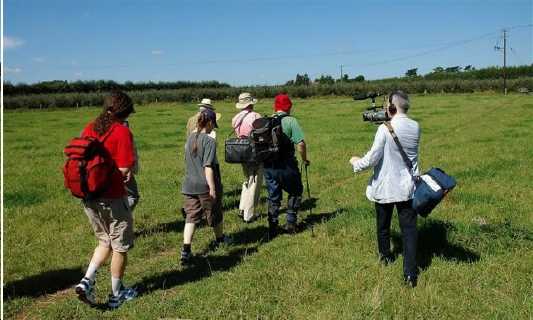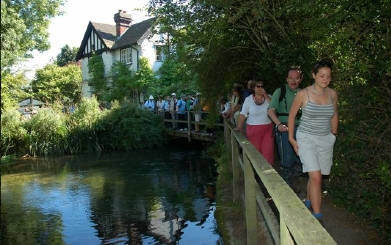|
The Michael Powell Centenary Walk
|
|

|
Left: at the junction of Station Approach and Station Road, near the Victorian railway viaduct where Michael watched boat trains thundering towards Dover. Two post- Powell modifications to the viaduct were noted: a massive steel girder inserted between the piers in the Second World War to enable the viaduct to bear the weight of trains hauling heavy military vehicles and munitions; and a pillbox built into one of the arches. Below: in School Lane, where we passed a Victorian post box in which many Powell letters must have been deposited in the early 1900s.
|
|
EVERY year, on the last Sunday in August, admirers of Michael Powell and Emeric Pressburger and devotees of their A Canterbury Tale, meet in or near Canterbury to enjoy a guided location walk in aid of Kent Kids Miles of Smiles and to re-enact some of the key scenes at the places where they were filmed in the summer of 1943.
In 2005 the walk was scheduled to take place on August 28, a few weeks before the centenary of Michael's birth. This was an ideal opportunity to combine location-hunting with a visit to the place where he was born and the countryside in which he grew up.
|
|
The event was organised by Paul Tritton and Steve Crook of the Powell & Pressburger Appreciation Society and attended by more than 80 enthusiasts.
The walk, from Bekesbourne to Wickhambreaux, began at Bekesbourne Railway Station (Ordnance Survey Grid Reference TR 189 561) where an information panel entitled Valley of Mills and Manors depicted many of the features of the landscape that were familiar to young Michael.
|
|
|
|
|
|

Below and right: negotiating the first of many stiles. Too late for the first to arrive there, someone discovered that the gate beside the stile could be opened. From here the route took us across a field path Bekesbourne parish church, passing the Old Palace, once the home of Ian Fleming.
This gave some of the walkers a chance for some impromptu James Bond dialogue: 'Do you expect me to talk?' 'No, Mr Bond, we expect you to die'.
Above: Win Tamsitt, who was born in nearby Patrixbourne and attended Bekesbourne School, wisely brought along a folding chair to use whenever we were allowed to rest awhile. Win's husband Jimmy Tamsitt played 'Terry' in A Canterbury Tale.
|

To Bekesbourne
parish church,
where Michael
was baptised
|

|
|
|
|

|
Across the
'bottom
land' at
Howletts
Farm
|
|
|
We arrived at Bekesbourne Church (TR 195 555) 99 years and nine months after Michael was baptised there. In the churchyard we found the war memorial, with the names of soldiers who served with The Buffs at the same time as Michael's father, the grave (below) of Charles Tilstone Beke (1800-1874), explorer and author of Origines Biblicae, The Sources of the Nile and The British Captives in Abyssinia. Leaving Bekesbourne, we followed the course of the Nailbourne stream that fascinated young Michael to a bridge under the railway (TR 195 558) and then took a footpath through Howletts Farm's 'bottom land'. This is now meadows and orchards but one hundred years ago it was Thomas Powell's hop-garden. Wild hops were growing in the hedgerows - descendants, no doubt, of his cultivated varieties. By now, David Thompson of BBC Television had joined us and was shadowing the leaders, shooting footage for a documentary.
|

|

|
|
|
|

|
|
By now the group had become a crocodile nearly two hundred yards long. This meant that at each halt it took five or ten minutes to regroup. Consequently the walk, scheduled to take four hours to cover the six miles, eventually took six hours. One of the stiles (below) crossed an electrified fence, so extra care was needed here.
|

|
|
|
|

|
|
At Howletts Farmhouse (TR 194 563) due homage was paid to Michael Powell and the plaque (inset) erected in his memory in 1996 was admired and photographed.
|

|
|
|
|

|
|
For some time now the walkers had glimpsed 'Nettle Abbey' in the distance and many had assumed that the building was a group of prehistoric standing-stones. A footpath from Howletts Farmhouse took us back to the course of the Nailbourne and on to the ruin (TR 201 565). Here, the group heard the story of the Well Chapel and the 'Waters of Woe,' and explored the complex of streams and springs where the waters of the Nailbourne merge with the source of the Little Stour. At Littlebourne many pints of beer and soft drinks were consumed at the pubs overlooking the village green, close to the bridge over the Little Stour that Michael described in his memoirs as carrying the road to Wingham Well, where his Auntie Chrissie and Uncle Will lived in a black-and-white timber farmhouse.
|

|
|
|
|

|
The watermills
that Michael
knew as a boy
|
|
Leaving Littlebourne, we crossed the bridge over Michael's 'road to Wingham Well' and a footbridge to the millpond at the site of Ickham Mill (TR 212 577). This was the first of three watermills that Michael mentioned in his memoirs when he recalled how, during the Second World War, he brought his film crew to this valley to take shots of his 'nursery memories'. Near the millpond we inspected photographs of the watermills as they were when Michael first visited them. A detour through Littlebourne churchyard (TR 201 578) took us past the grave of three local people who appeared as extras in the hoppicking scene filmed at Elbridge Farm for A Canterbury Tale - hop farmers Ernest Holdstock and son John, and Ernest's daughter 'Bintie'.
|

|
|
|
|

|
Past a paddock
and down the river
to Wickhambreaux
|
|

|
From the churchyard a footpath led through a paddock,
past Littlebourne Mill (TR 215 581) and to the bank of
|
|
the Little Stour, where Wickhambreaux (TR 221 587),
our destination, beckoned.
|

|
At Wickhambreaux Mill and the former Post Office we performed two playlets. These re-enacted dialogue from the scenes in which Alison and Bob's horsedrawn cart passes the mill and Alison meets Dorothy, the postwoman ('Blimey!'). Michael Eyers played Bob, Valerie Ainscough and Sally Juniper took turns as Alison and Margaret Hall from Poplar, London E14, brought exactly the right accent to the role of Dorothy, the postwoman.
|
|
|
|

|
Left: passing Wickhambreaux Watermill ('a great piece of weatherboarding': Bob Johnson) on our way to the vilage green where, with Wickhambreaux Court (Thomas Colpeper's house) in the background, Julie Ede opened the next playlet with Alison's immortal comment, 'What wouldn't I give to grow old in a place like that!' Wendy
|
|
Fraser came in on cue as Mrs Colpeper with 'Tom! Breakfast!' and Canadian visitor Jan Gray convincingly adapted his accent to play Bob as the scene progressed to the moment when Alison and Bob, having travelled through the village discussed their sad love affairs and parted company on the downs.
|
|
'A great piece of weatherboarding'
|

|

|
At the rear entrance to Wickhambreaux Court, for a glimpse of the garden where a startled Alison saw Colpeper scything his lawn before being called in to have his breakfast.
|
|
|
|

|
|
The final playlet. Hylton Holt (left, as Colpeper), David Collard (Peter Gibbs) and Barbara Stannard (Mrs Colpeper) re-enact the scene in which Gibbs and Colpeper are interrupted during their Sunday afternoon talk by the arrival of the salvage boys with 'Ovenden's
|
|
donkey.' Life imitated art during this playlet, when a van belonging to local plant and lorry hire firm Ovenden parked beside the green. Below: a final photocall before last orders at the pub on the green and the long trek back to Bekesbourne.
|

|
|


























